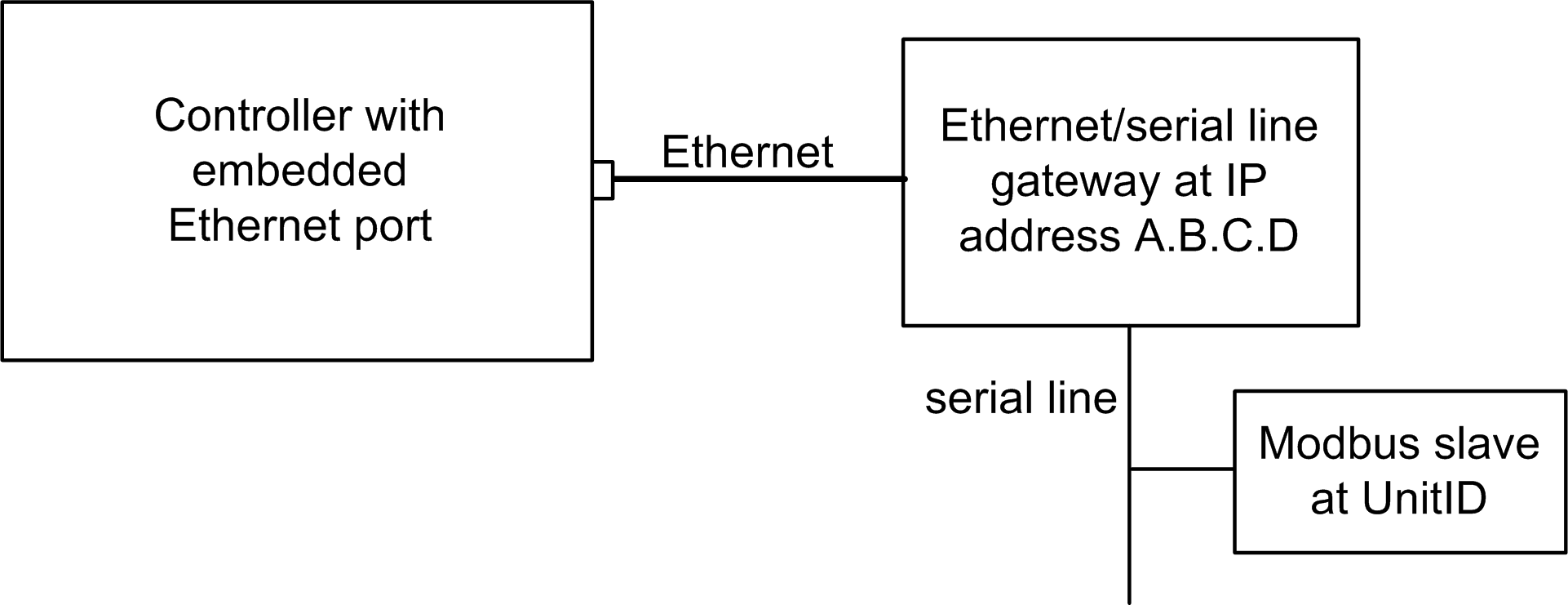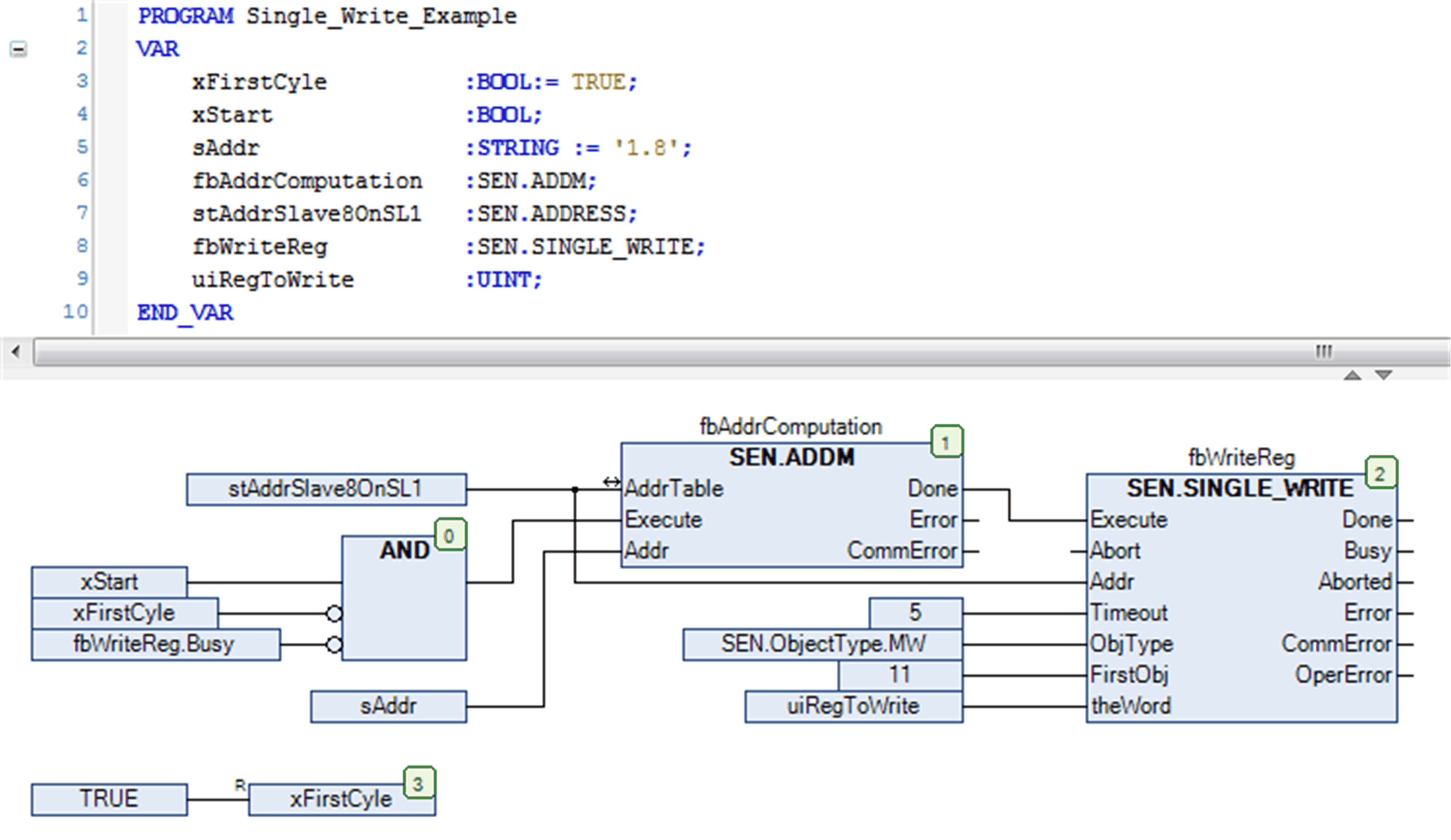ADDM: Convert a String into an Address
Function Description
The ADDM function block converts a destination address that is represented as a string to an ADDRESS structure. You can use the ADDRESS structure as an entry in a communication function block.
ADDM - Specific Parameter Description
|
Input/Output |
Type |
Comment |
|---|---|---|
|
|
ADDRESS |
This is the ADDRESS structure to be filled by the function block. |
|
Input |
Type |
Comment |
|---|---|---|
|
|
BOOL |
Executes the function at the rising edge. |
|
|
STRING |
Address in STRING type to be converted in ADDRESS type (see details below). |
|
Output |
Type |
Comment |
|---|---|---|
|
|
BOOL |
NOTE: When the operation is aborted with the Abort input, Done is not set to 1 (only
Aborted).
|
|
|
BOOL |
|
|
|
BYTE |
|
Execute input executes the conversion and returns an immediate update of AddrTable. However, AddrTable retains the last value when an error is detected (that is when the Addr string is not correct).
Function blocks require a rising edge in order to be initiated. The function block needs to first see the Execute input as FALSE in order to detect a subsequent rising edge.
| WARNING | |
|---|---|
Addr STRING for ASCII Address Format
For ASCII addressing, only the communication port number is requested:
'<communication port number>'
For example, to send a user-defined message on serial line 2, use the string '2'.
This table defines the fields in the ADDM output for the ASCII address format:
|
Field |
Type |
Value |
Example |
|---|---|---|---|
|
|
BYTE |
Reserved |
Not used |
|
|
BYTE |
Reserved |
Not used |
|
|
BYTE |
Rack number (always 0) |
0 |
|
|
BYTE |
Module number (always 0) |
0 |
|
|
|
2 |
|
|
|
BYTE |
Not used |
Not used |
|
|
BYTE |
0 |
0 |
|
|
BYTE |
Not used |
Not used |
|
|
ADDR_EXT |
Not used |
Not used |
Addr STRING for Modbus TCP Address Format
Address of a Modbus TCP Standard Slave
For the Modbus TCP standard slave address format, the communication port number (3 for the embedded Ethernet port) and the destination IP address are requested:
'<communication port number>{<IP address>}'
UnitId default value). However, a Modbus TCP device may have different value (for example, a TeSys has Modbus address 1). In this case, add the UnitId value:
'<communication port number>{<IP address>}<UnitId>'
TCP port 502 is used by default. It is possible to use a non-standard port by adding the requested port number to the IP address:
'<communication port number>{<IP address>:<port>}'
For example, to send a message at Modbus TCP slave IP address 192.168.1.2 using standard TCP port 502, use this string: '3{192.168.1.2}'
The ADDM function fills the AddrTable input/output with these values:
|
Field |
Type |
Value |
Example |
|---|---|---|---|
|
|
BYTE |
Reserved |
Not used |
|
|
BYTE |
Reserved |
Not used |
|
|
BYTE |
Rack number |
0 |
|
|
BYTE |
Module number |
0 |
|
|
|
3 |
|
|
|
BYTE |
0 for Modbus |
0 |
|
|
BYTE |
|
7 |
|
|
BYTE |
Modbus address (255 by default) |
255 |
|
|
TCP_ADDR_EXT |
A |
192 |
|
B |
168 |
||
|
C |
1 |
||
|
D |
2 |
||
|
<port> (default = 502) |
502 |
Address of a Modbus Serial Slave Through Ethernet/Serial Line Gateway
It is also possible to address a Modbus slave through an Ethernet/serial line gateway:

The request includes the communication port number, gateway IP address with or without TCP port), and the Modbus serial slave address (UnitId parameter):
'<communication port number>{<IP address>}<slave address>'
For example, to send a message at Modbus Serial slave address 5 through a Ethernet/serial line gateway at IP address 192.168.1.2 using standard TCP port 502, use this string: '3{192.168.1.2}5'
The ADDM function fills the AddrTable input/output with these values:
|
Field |
Size |
Value |
Example |
|---|---|---|---|
|
|
BYTE |
Reserved |
Not used |
|
|
BYTE |
Reserved |
Not used |
|
|
BYTE |
Rack number |
0 |
|
|
BYTE |
Module number |
0 |
|
|
|
3 |
|
|
|
BYTE |
0 for Modbus |
0 |
|
|
BYTE |
|
7 |
|
|
BYTE |
<Slave address> |
5 |
|
|
TCP_ADDR_EXT |
A |
192 |
|
B |
168 |
||
|
C |
1 |
||
|
D |
2 |
||
|
TCP port number (default = 502) |
502 |
Example
This example shows the implementation of the ADDM function block in conjunction with the SINGLE_WRITE function block. The ADDM function block converts the given STRING '1.8' to the variable stSlave8OnSL1 of type ADDRESS. If the conversion was successful the input Execute of subsequent function block SINGLE_WRITE is triggered.

